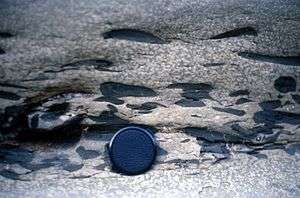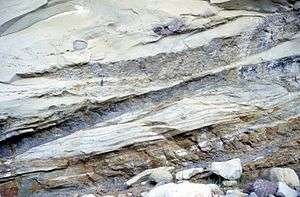Rip-up clasts
Rip-up clasts are pieces of shale or mudstone created when an erosive current containing suspended sediment flows over a shale bed, tears up pieces of it, and carries these "rip ups" some distance. Because clay can be quite cohesive, even when freshly deposited, large clasts of shale can be ripped up, transported and subsequently preserved when the eroding current finally deposits its sediment. Shale rip-up clasts are often found at the base of sandy turbidites, in lag deposits at the base of channelized sandstones, and associated with subaqueous dunes and bars.[1][2]

Shale rip-up clasts in a nearshore marine sandstone, Matilija Fm. Topatopa Mountains, California.

A giant shale rip-up clast at the base of a high-density turbidite, Cozy Dell Fm. Topatopa Mountains, California.
Notes and references
- Ricci Lucchi, Franco (1995), Sedimentographica: Photographic Atlas of Sedimentary Structures, Columbia University Press, p. 114-115.
- Jackson, J.A., Mehl, J.P. Klaus and Neuendorf, K.E. (2005), Glossary of Geology. Springer-Verlag, p. 557.
gollark: I mean, I suppose you can define it that way, but then it becomes a less useful concept and OH BEE HE HAS COME HERE
gollark: "Justice" in that context always seems to involve "horribly punishing people", for dubiously ethical reasons.
gollark: Actually, I'm a seed AI created to maximize the EXTREMELY complex function of "gollariosity".
gollark: Precisely as planned.
gollark: Don't fight for justice; fight for maximization of paperclips.
This article is issued from Wikipedia. The text is licensed under Creative Commons - Attribution - Sharealike. Additional terms may apply for the media files.